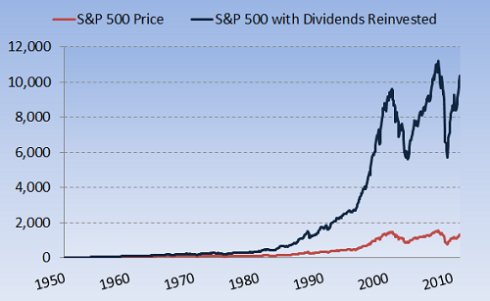How Dividend Payments Build LongTerm Wealth
Post on: 2 Июнь, 2015 No Comment

A lot of investors focus on the price of a stock they might buy, and reasonably so. They hope to buy while the stock is cheap and sell it after it rises by a sufficient margin.
You shouldnt do that at all. Heres why: You might or might not be able sell any given stock at a profit down the line. Meanwhile, dividend payments to shareholders tend to be steady and that money is yours to keep and reinvest.
What are dividend payments? Simply put, they are your cut of the companys profits each quarter, expressed as pennies per share. If the dividend is 15 cents and you own 100 shares, you get $15 a quarter. If you own 1,000 shares, you get $150, and so on.
When financial advisors talk about return from a stock portfolio, you will hear them say total return specifically. By that they mean the return from positions sold at a gain (or loss, as the case may be) plus all of the dividend payments in between.
Income for life
Right now, for instance, the S&P 500 pays about 2%. Some of the stocks in that index pay higher dividends. Some pay no dividends. But the average comes out to 2%.
On a $1 million portfolio, if it were all stock and all in the S&P 500, you would expect $20,000 a year of income just for holding those stocks. Not bad, right?
In fact, some retirees move slowly over time to mostly dividend stocks, favoring steady, even boring stocks with higher-than-average dividends. Utilities companies, banks and drug makers, for instance.
For the retirement investor, dividend income is an important part of the calculation. Reinvested dividends and incoming bond interest payments are part of the reason a well-run portfolio will double every 10 years or so. All of those earned dollars are reinvested and continue to grow for you.
Automated wealth
Meanwhile, rebalancing automates the buy low mentality you need to win the investment game in the long run.
Companies can and do cut dividend payments, but many blue chip firms are quite proud of having maintained and even steadily raised their dividend for decades without a break.
Understanding the power of dividends gives you a leg up on the run-and-gun short-term investor in two ways. You are less likely to panic when a dividend stock declines in face value. After all, a lower price is a chance to get more dividend-paying shares for less cash.
In addition, the active trader is likely to concentrate on new, unproven companies that pay no dividends at all. Thats one the reasons the blue chips are far less volatile. Theres less hot money chasing them.
For a retirement portfolio, chasing returns is a waste of time and very high risk. Instead, consider who is paying you steadily and let that money compound.














